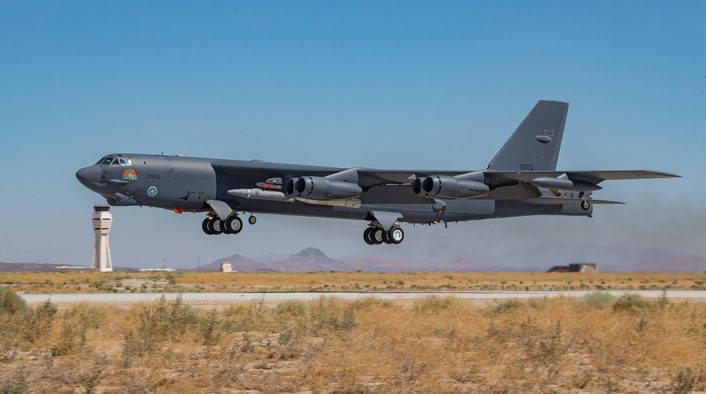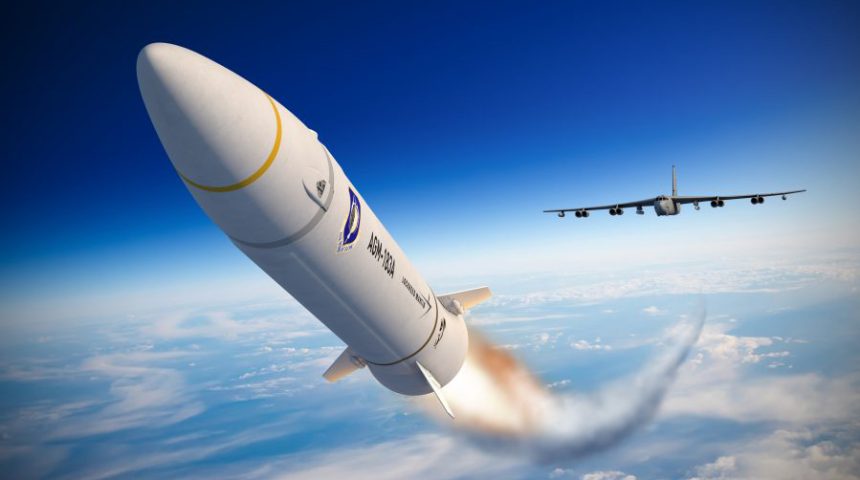The first flight test of the AGM-183A ARRW failed on Monday, April 5, 2021, over the Point Mugu Sea Range.
The U.S. Air Force’s long-awaited first flight test of its hypersonic AGM-183A ARRW (Air-launched Rapid Response Weapon), a boost-glide hypersonic system being developed by Lockheed Martin, failed when “the first booster vehicle flight test encountered an issue on the aircraft and did not launch” on Apr. 5, 2021.
According to a release, a B-52H Stratofortress bomber took off and headed over the Point Mugu Sea Range intending to fire the first booster test vehicle for the AGM-183A, but the test missile was unable to complete the launch sequence and was not released by the “mothership” that returned to Edwards AFB, where it safely landed.
Breaking: Air Force’s ARRW flight test fails. Release: pic.twitter.com/x0yXRPlMFR
— Brian Everstine (@beverstine) April 6, 2021
The test was actually “spoiled” by the presence of a NASA WB-57F and a Navy P-3 over the Pacific Ocean near the Point Mugu Sea Test Range, located southwest of Los Angeles.
Looks like today might be the day of the first hypersonic #ARRW test. NASA WB-57F orbiting at FL500. The type has been used to film missile and rocket launches. Navy Orion also in the area. pic.twitter.com/IT0lkUqZtV
— David Cenciotti (@cencio4) April 5, 2021
In particular, the WB-57F registered N927NA, is one of the NASA Canberras based at Ellington Field, Texas, but often deployed to different bases, both within CONUS and abroad to conduct “special operations” alongside scientific research projects (on hurricanes, radiation impact on clouds, and so on). The aircraft with up to 6,000-lb payload carried and a pallet system under the main fuselage area, can fulfil a wide variety of special missions, including filming rockets and missile launches. Like the attempted first one of the AGM-183A.
For instance, in 2007 there were speculations and theories about the type of mission flown by the WB-57 in war zones fueled by pictures of the aircraft operating from Kandahar airfield in Afghanistan without the standard NASA logo and markings. Officially, the aircraft performed geophysical and remote sensing surveys as part of the U.S. aid to the Afghan reconstruction effort. The WB-57 collected AVIRIS (Airborne Visible Infra Red Imaging Spectrometer) data that could be analyzed to provide information on mineral assemblages that could aid in resource and hazards assessments.
Then, the WB-57s carried BACN – Battlefield Airborne Communications Node payloads in Afghanistan, often testing new sensors and antennas used by the BACN to relay comms between command and control centers and ground troops located within valleys and ridges in the Afghan mountains during specific testing campaigns from Nellis Air Force Base, Nevada.
In Afghanistan these unique aircraft have been used to test Northrop Grumman’s Battlefield Airborne Communications Node (BACN) a technological “gateway” system that allows aircraft with incompatible radio systems and datalinks to transfer information and communicate.

Back to the AGM-183A ARRW, the strike weapon consists of a rocket booster and hypersonic glider warhead. After being launched from an aircraft, the booster rocket accelerates to high speeds before releasing the hypersonic glide warhead payload which then glides unpowered to its target at hypersonic speeds up to Mach 20.
“The ARRW program is a rapid prototyping project aimed at delivering a conventional hypersonic weapons capability to the Warfighter in the early 2020s,” says the U.S. Air Force. “The weapon system is designed to provide combatant commanders the capability to destroy high-value, time-sensitive targets. ARRW will also expand precision-strike weapon systems’ capabilities by enabling rapid response strikes against heavily defended land targets.”
As explained in a previous article, “the Air Force is currently looking to obtain a range of capabilities in hypersonics, with a range of weapons in different size categories. As a matter of fact, the service is looking both at a larger weapon with greater range to be carried by the bombers and a smaller one with less range or payload to be carried by fighter aircraft too. An example of this was seen in the F-15EX’s renderings which featured a hypersonic missile under the fuselage’s center pylon. The introduction in service of hypersonic missiles in the next years will increase the firepower of the B-52, the first scheduled to receive the new weapons, and the B-1. Gen. Ray stated that the AGM-183 ARRW should be integrated on the B-1 as soon as possible, as the bomber is expected to perform excellently in the standoff role with the weapons carried on the external pylons.”









